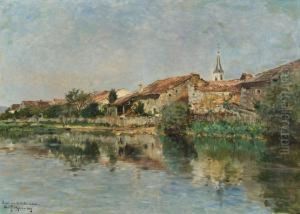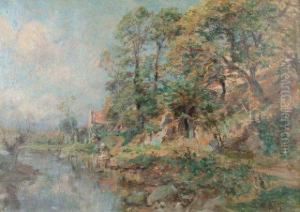Edmond Petit Jean Paintings
Edmond Marie Petitjean was born on July 5, 1844, in Neufchâteau, in the Vosges department of France. Though less renowned than some of his contemporaries, Petitjean made significant contributions to the French art scene of the 19th and early 20th centuries. He is best remembered for his landscape and marine paintings, which exemplify the transition from traditional landscape painting to the more impressionistic style that dominated French art at the turn of the century.
Petitjean's early life was marked by a passion for art, leading him to pursue his studies at the École des Beaux-Arts in Paris. Under the tutelage of esteemed artists such as Émile Michel and Alexandre Cabanel, Petitjean honed his skills, gravitating towards landscape and seascape painting. He was particularly influenced by the Barbizon school, known for its naturalistic depiction of rural France, as well as by the burgeoning Impressionist movement, which emphasized light and color.
Throughout his career, Petitjean exhibited his work extensively. He made his debut at the Paris Salon in 1874, where he continued to display his paintings regularly, earning accolades for his vibrant and atmospheric compositions. His ability to capture the transient effects of light on water and landscape garnered him a reputation as a master of color and texture. Petitjean traveled extensively throughout France, drawing inspiration from its diverse landscapes, from the rugged coasts of Normandy to the serene waterways of the Loire Valley.
Despite his alignment with the aesthetic principles of Impressionism, Petitjean never fully adopted the movement's more radical techniques, such as the use of unblended brushstrokes. Instead, he struck a balance between the meticulous detail of traditional landscape painting and the impressionistic interest in light and atmosphere. This unique approach allowed him to create works that were both evocative and precise, capturing the essence of his subjects without sacrificing clarity.
Edmond Marie Petitjean's contributions to French art were recognized in his lifetime; he was awarded the Legion of Honour in 1892. He continued to paint and exhibit his work until his death on August 8, 1925, in Paris. Today, his paintings can be found in several French museums, including the Musée d'Orsay, and in private collections around the world. Though not as widely celebrated as some of his peers, Petitjean's work remains a vital part of the narrative of French landscape and marine painting, bridging the gap between the traditional and the modern.

